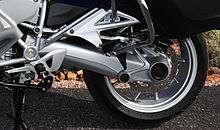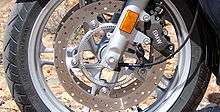Swingarm

A swingarm, or "swinging arm" (UK), originally known as a swing fork or pivoted fork, is the main component of the rear suspension of most modern motorcycles and ATVs. It is used to hold the rear axle firmly, while pivoting vertically, to allow the suspension to absorb bumps in the road.
Originally motorcycles had no rear suspension, as their frames were little more than stronger versions of the classic diamond frame of a bicycle. Many types of suspension were tried, including Indian's leaf spring suspended swingarm, and Matchless's cantilevered coiled-spring swingarm. Immediately prior to and after World War II, the plunger suspension, in which the axle moved up and down two vertical posts, became commonplace. In the latter, the movement in each direction was against coiled springs.
Some manufacturers, such as Greeves, used swingarm designs for the front forks, which were more robust than telescopic forks. In particular, sidecar motocross outfits frequently use swing arm front forks. The swingarm has also been used for the front suspension of scooters. In this case it aids in simplifying maintenance. In motorcycles with shaft drive, such as the Yamaha XJ650 Maxim, the shaft housing forms the left side swingarm.

Swingarm types
Swingarms have come in several forms:
Swinging fork - the original version consisting of a pair of parallel pipes holding the rear axle at one end and pivoting at the other. A pair of shock absorbers are mounted just before the rear axle and attached to the frame, below the seat rail.
Cantilever - An extension of the swinging fork where a triangulated frame transfers swingarm movement to compress shock absorber/s generally mounted in front of the swingarm. The HRD-Vincent Motorcycle is a famous early form of this type of swingarm, though Matchless used it earlier, and Yamaha subsequently. The Harley-Davidson Softail is another form of this swingarm, though working in reverse, with the shock absorbers being extended rather than compressed.

Parallelogram Suspension was first introduced commercially in 1985 on the Magni "Le Mans". Magni called the system Parallelogrammo. Various parallelogram systems have been developed by other manufacturers.[1]
Whereas a chain-driven bike would "squat" at the rear under acceleration,[2] a shaft drive machine would do the opposite, causing the seat (and rider) to rise upwards, a phenomenon known as "shaft-jacking". This anti-intuitive sensation can be disconcerting to riders, and parallelogram suspensions seek to neutralize such unwelcome torque reactions.

Paralever is BMW's version of the system. It allows the driveshaft to pivot along the same axis as the sprung rear frame due to the addition of a second link between the rear drive and transmission. The Paralever was introduced in 1988 R80GS and R100GS motorcycles to combat shaft-jacking.
Moto Guzzi has introduced a variant of the system, it named the Compact Reactive Drive Shaft system (patented and named Ca.R.C.). The main difference is that the driveshaft is free to float into its structure, providing much softer feedback from transmission. Additionally, the upper arm of the Ca.R.C. is not part of the structure but just a guide to close the geometry of the suspension (it means that, unlike the BMW version, the suspension will work also with a broken upper arm).
Drag racing motorcycles (called dragbikes) will often use longer swingarms to keep their center of gravity as forward as possible, which reduces the tendency to wheelie at the start.


A single-sided swingarm is a type of swingarm which lies along only one side of the rear wheel, allowing the rear wheel to be mounted like a car wheel (unlike the conventional motorcycle double-sided swingarm). Single-sided swingarms are traditionally found on small motorcycles or scooters, where a robust chain case doubles as the swingarm linking the engine and rear wheel. Single-sided swingarms need to be much stiffer than the double-sided versions, to accommodate the extra torsional forces, and as a result, they are usually heavier than double-sided arms. Having a single mounting point guarantees proper wheel alignment.
Single-sided swingarms date from at least the late 1940s. In 1948 the Imme R100 produced by Norbert Riedel of Germany had both a single-sided front wheel suspension as well as a single-sided rear swingarm that doubled as the exhaust pipe.[3] Later in 1950, Moto Guzzi introduced the Galletto, a large-wheel step-through scooter. In 1980, BMW introduced its first single-sided swingarm on the R80G/S, the "Mono-lever", which was superseded by the "Para-lever" used currently. Honda currently features this style of swingarm on the Honda VFR. Ducati has created several models featuring single swingarms, most notably the Massimo Tamburini-designed 916 series. While Ducati abandoned this style for the 999, the company returned to it for the 1098 superbike in 2007, and it survives in the current Ducati 1199. The Triumph Sprint ST also features a single-sided swingarm.[4]
Squat and Shaft-jacking
"Squat" occurs because the top of the final drive chain run pulls the swingarm upwards; "Shaft-jacking" occurs because the shaft drive bevel gear tries to "climb up" the large bevel gear in the wheel hub, thereby pushing the swingarm downwards and away from the frame.[5]
Shaft-jacking can be minimised by devices such as parallelogram swingarms. A practical way to minimise squat on a chain-drive bike is to locate the final drive sprocket as close as possible to the axis of the swingarm pivot; the ideal solution is to make the final drive sprocket and the swingarm pivot concentric, as was done on the Hesketh V1000.
See also
References
- ↑ "Magni history". Magni. Retrieved 2008-03-15.
- ↑ http://www.suspact.com/Anti_Squat.html
- ↑ Kruger, Ralf (2012-01-16). "Outstanding German two-strokes we shouldn't forget: Part Four, the 1950s". Ed Youngblood's MotoHistory – Ed Youngblood's News & Views – January 2012 Archive. Inverness, FL USA. 5th article down. Archived from the original on 2012-05-16. Retrieved 2012-02-26.
This enabled the longish exhaust pipe to double as a single-sided swing arm for the rear wheel!
External link in|work=(help) - ↑ http://www.triumphmotorcycles.co.uk/motorcycles/range/touring/sprint/2011/sprint-st
- ↑ "Motorcycle Handling and Chassis Design: The Art and Science" -Tony Foal
